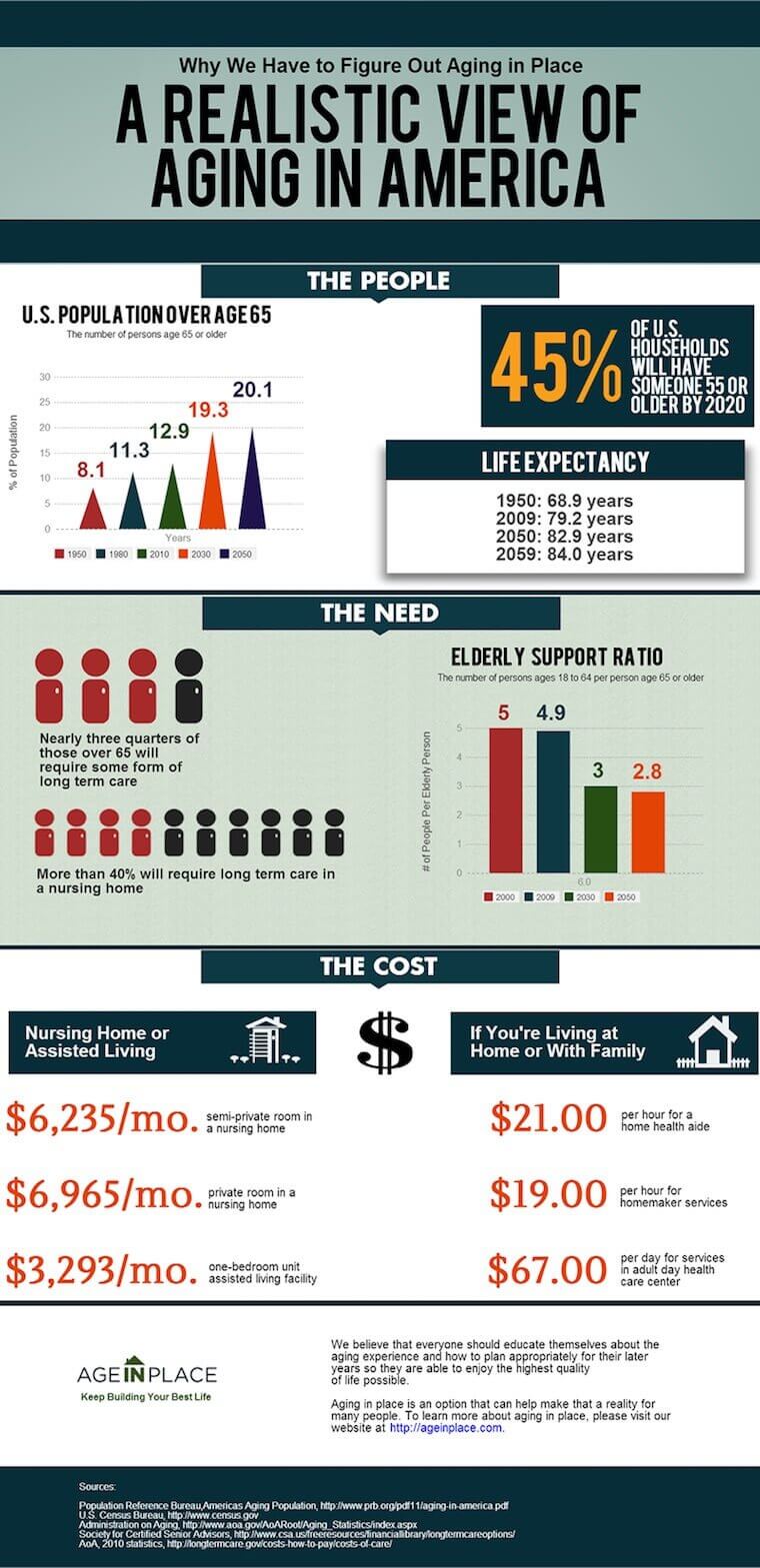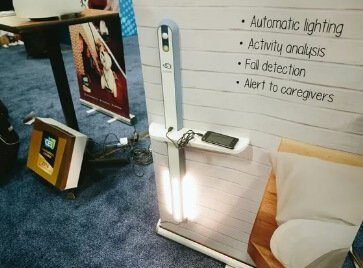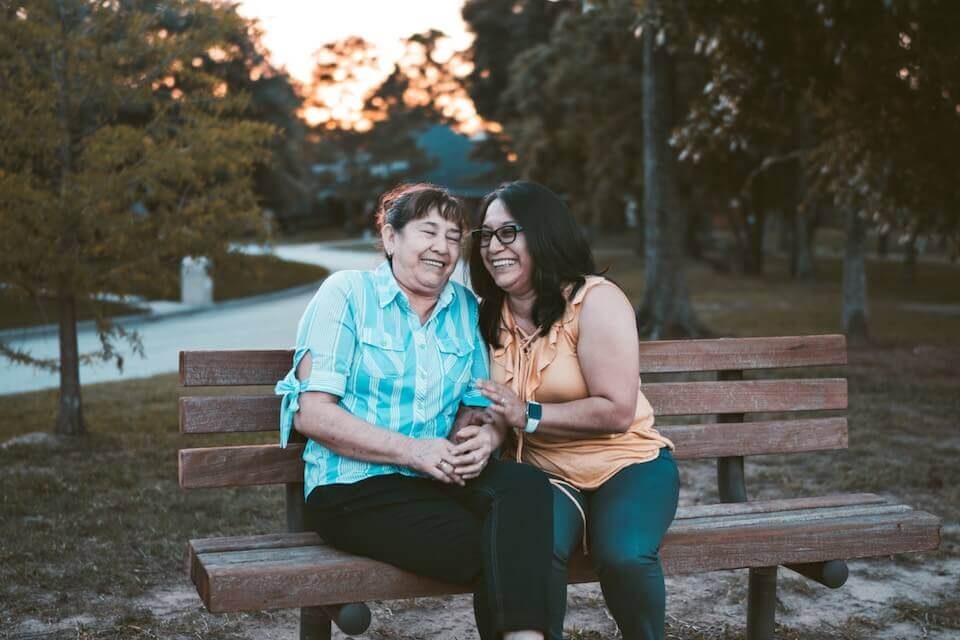Aging in place is a term that’s quickly growing in popularity.
On a basic level, aging in place means a person can continue living in the residence of his or her choice while aging. When this happens, a person generally needs to receive more services and assistance as time passes.
The aforementioned act is a delicate balance, though.
To do it with success, an elderly person needs to maintain his or her quality of life and continue to carry out activities of daily living. For many seniors, this means getting extra help to ensure living in a specific residence continues to be a healthy option.
Although everyone ages differently, some common experiences include reduced vision, mental processing ability, muscle strength, mobility and hearing. Others experience increased risk of falls, illness and depression.
Luckily, there are many services and technologies that help elders and their families combat the changes that commonly develop later in life.
Relevance
Many elderly struggle with everyday tasks, from making meals to driving safely.
For a lot of people in this age range, it’s common to live alone or with an elderly spouse, which means there’s not a lot of help available to ensure a healthy quality of life is maintained.

By 2030, there will be about 71.5 million Americans over 65-years-old. The challenges that will be created when around 20 percent of the United State’s population is over 65 years of age is hard to imagine. The current economic problems, issues with the healthcare system and more will pose a serious hurdle for America.
Elders’ Caregivers
The majority of the tasks associated with caring for seniors generally falls to families.
When a senior needs home remodeling to improve its livability, families are often required to make the modifications or hire a company that can remodel. Caring for an elder also puts a significant time strain on a family, as they have less time for themselves, each other and other obligations.
It’s not easy to help someone spend his or her retirement years as imagined, remodel a home as a senior’s needs change, make sure healthcare is accessible and access various support services that are required to maintain a high quality of life.
Making It Happen
Clearly, aging in place is a big undertaking. So, how do people make it a reality? First, they plan, and they plan early. You don’t want to create a plan once someone is in need, you want to create a plan when independence is still intact.
Just like you might create a will, it’s important for you to create a plan that’ll ensure your quality of life. While you age with dignity, you also want to make sure you’re not too big of a burden on your family or community.
Before you’re of retiring age, research your options and come up with a plan that’s what you want. If you’ve already retired, it’s still not too late to create an outline for your retirement years.
Finding a Home
Seniors who want to continue living in the same home as they age will need to modify the space as needs change. That said, aging in place doesn’t necessarily mean living in your current home for as long as possible.
Another option is to find a more appropriate house that you won’t need to remodel. For example, you might find a home that has less stairs and provides easy access to the things needed for daily life.
As you consider where you’d like to live, remember that safety is the top priority. To stay as independent as possible for as long as you can, you need to put your health and safety first. One key aspect to keep in mind is selecting a space that’ll prevent falls.
After you fall, you’re more likely to fall again. Many of these accidents cause fractures and other injuries, which can require hospital time and possible nursing home admission as an outcome.
Avoiding Falls
Thinking in detail about preventing falls might seem unimportant, but this couldn’t be further from the truth. When you age, you might experience pre-existing conditions or medical complications that make falls extremely dangerous.
As the body ages, it has a hard time withstanding the trauma of a fall. Even if your body is able to handle the trauma from a fall, it might never recover.
Due to the seriousness of falls, everyone should understand what makes elders fall and how these accidents can be avoided. Lastly, it’s key to come up with a plan for what will happen if a fall does take place.
Fall Causes and Prevention
There are many reasons people fall, from loss of footing to slow reflexes and even decreased strength. Various blood pressure, sleeping and diuretic medications can also increase your fall risk.
To prevent falls, start by making sure you have access to proper shoes. Good shoes should fit well and have a grippy sole that prevents slipping. Using a cane, walker or having railing installed in a home is also a good idea that can help prevent falls.
One amazing way to prevent falls is with the help of technology. As vision decreases and balance declines, proper lighting is essential for ambulating. Smart lights can be controlled from anywhere, sometimes with your voice, and can dim and brighten on command.

A product that stands out in the smart lighting category is the wall-mounted Aladin. This light senses movement and illuminates the way as you walk by. In the event of a fall, the device can send a notification to your loved ones telling them you need help.
What to Do After a Fall
Although you might do everything in your power to prevent a fall, one still might happen. If you ever lose your balance and hit the ground, call 911 immediately. Of course, this is hard to do if you’ve lost consciousness or are unable to reach a phone.
The best way to combat this horrific situation is to invest in a medical alert system that detects falls and can connect you with emergency help when you need it most.
If you’re conscious after a fall, try to stay as relaxed as possible.
Even if you feel like you can get up, it’s best to wait for someone to assist you. Try to see if you have any instant feelings of discomfort or pain. If you’re aware of any light headedness or throbbing in your head, try to remember this symptom and report it as soon as possible.
Holistic Quality of Life
Quality of life is about more than having a standard of health.
Having a high quality of life means experiencing a lot of happiness, too. Planning to age won’t always be fun, but it absolutely should include some excitement as you think about your future happiness and how you can achieve it in the years to come.
For example, if you enjoy entertainment, you might want to purchase an Apple TV. This technology allows you to play podcasts, TV shows, movies and more on your television. With a HomeKit, you can even run smart thermostats, lights and other devices with the help of Siri on your Apple TV, making your life easier and more connected.
You may also become interested in other entertainment devices, like grandCARE. With grandCARE, you can use a large touchscreen to have video chats with family members and friends, play games, surf the web and more.
Another device that’s improving seniors’ lives is a virtual home assistant, like the Google Home. While you’re in the kitchen, you can ask Google Home for step-by-step recipe instructions. You can also ask it questions you have throughout your day, from “What’s the weather like outside?” to “What’s on my schedule for today?”

If you have a smart TV, you can even control it with voice commands via Google Home. Whenever you want to pause, rewind, skip or change your content, all you need to do is ask Google.
Best of all, Google Home has an unmatched microphone that can pick up your voice from a long ways away. Even if it’s playing music or sounding an alarm, it’ll detect your voice and respond to your commands.
Last, but not least, Google Home is a sleek device that looks good in any room. It’s short, stout and modern, meaning it won’t draw unwanted attention or take up unnecessary space.
Helpful Resources
Although there are many resources for aging in place, one of the best is the AARP’s website. In their ” Age-Friendly Archive,” you can find reports, studies and more that tackle the topic of helping older adults age in a home.
For technology, your go-to resources can be Aging In Place Technology Watch and HelpCloud. With the technology watch, you can stay updated on the latest tech tools and advice for remaining in your home as long as possible.
With HelpCloud, you can gain access to the help you need to ensure all your tech runs smoothly. After all, it’s clear that technology is inherently tied to the aging in place revolution.


